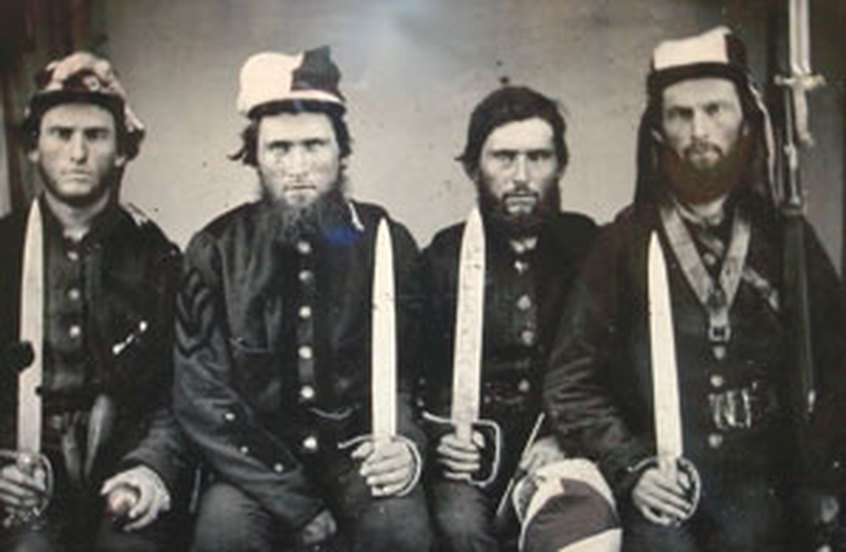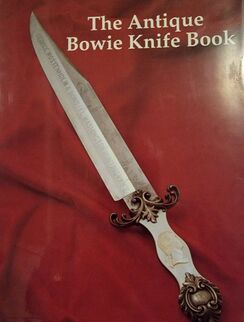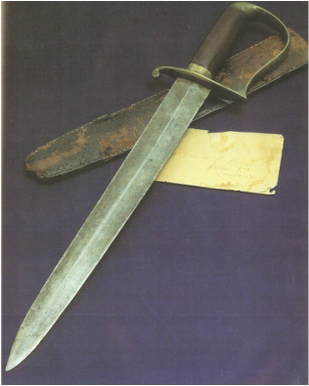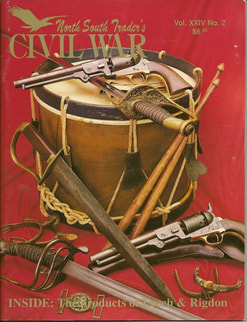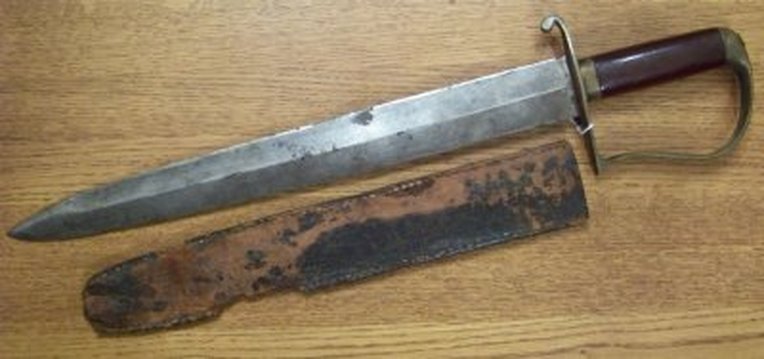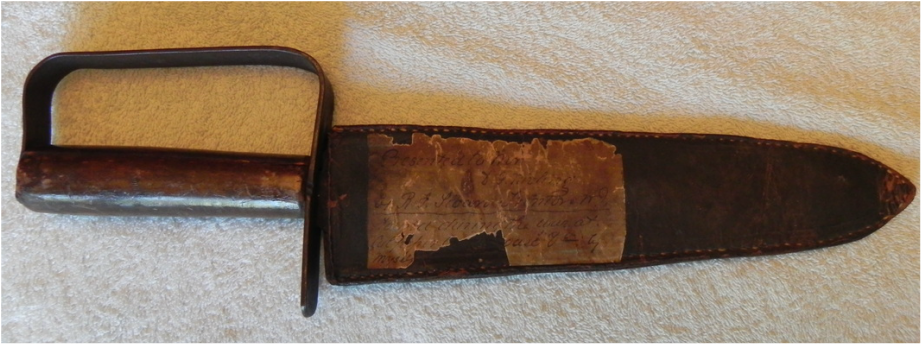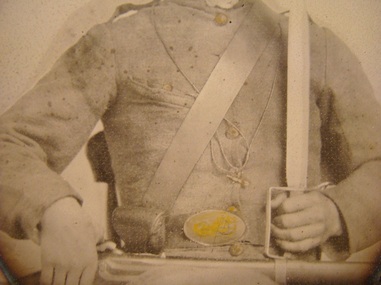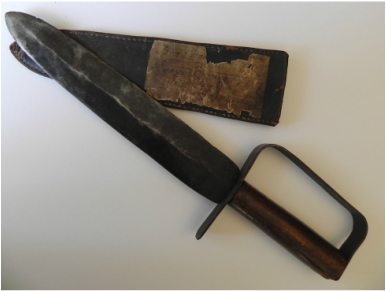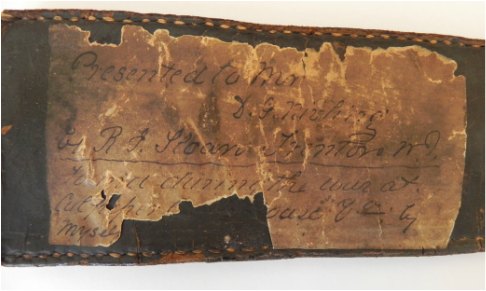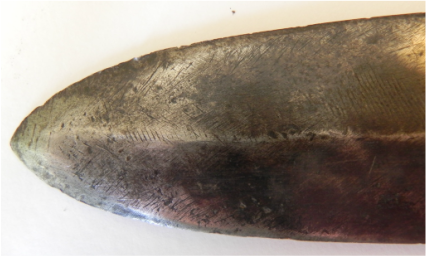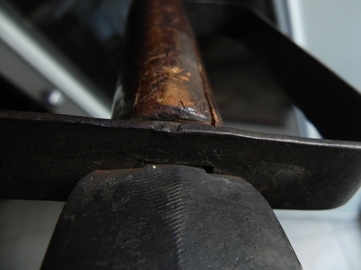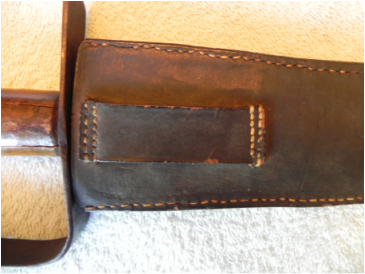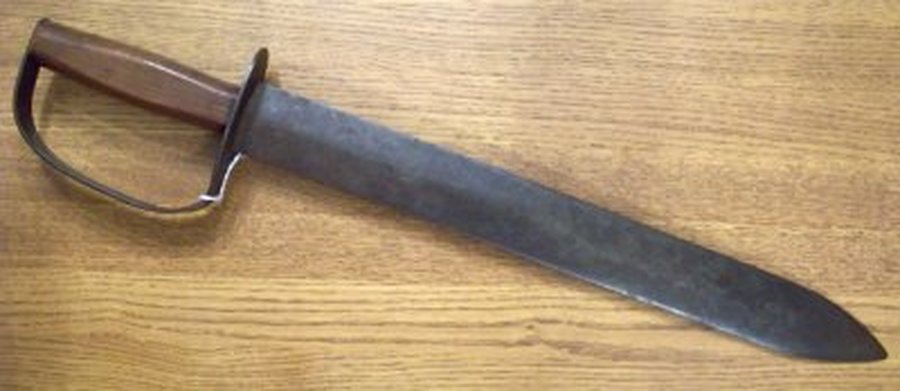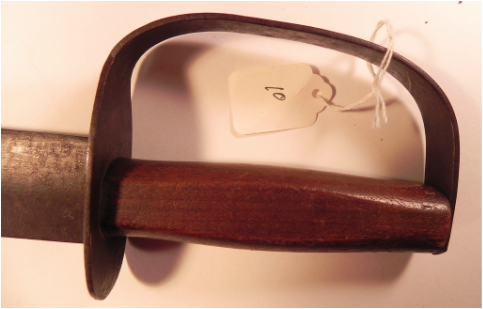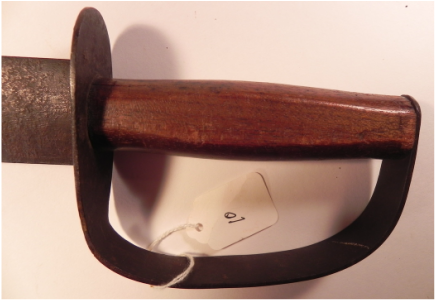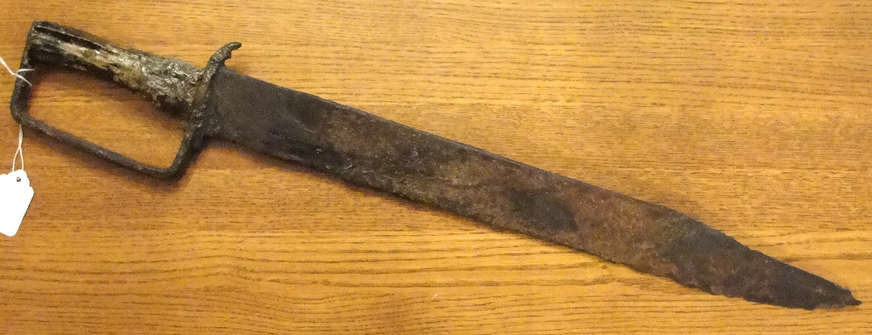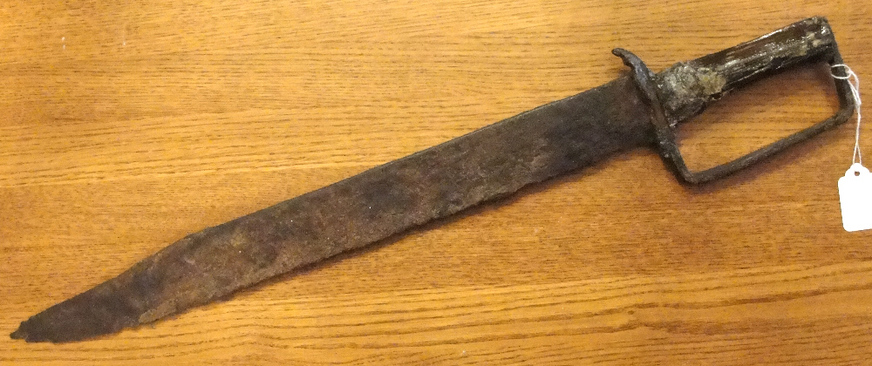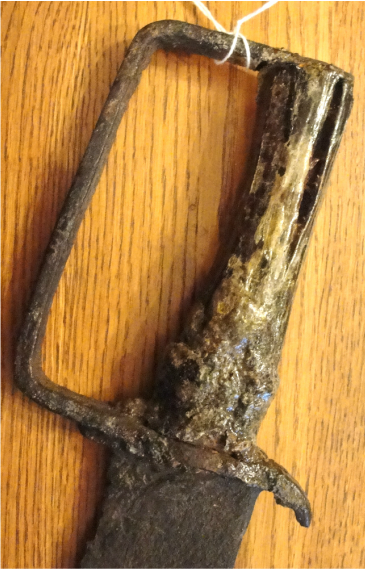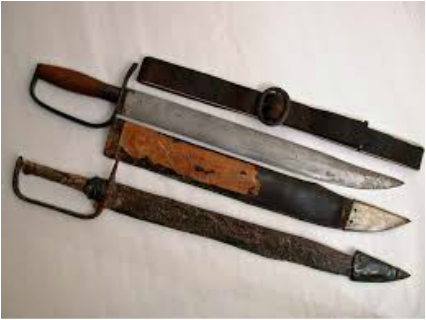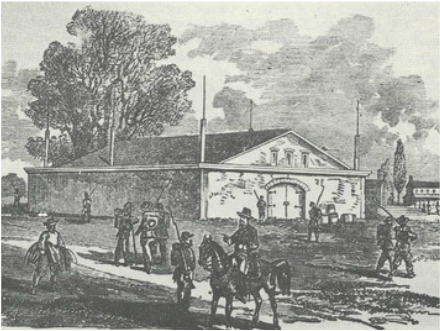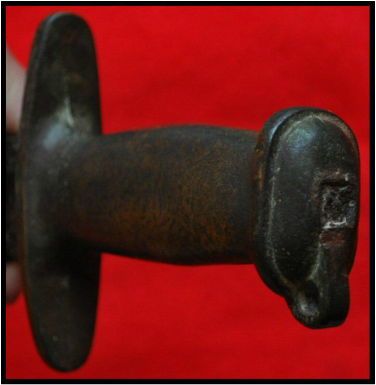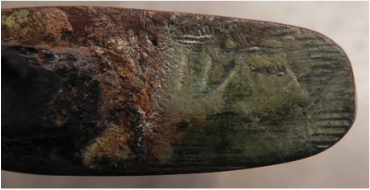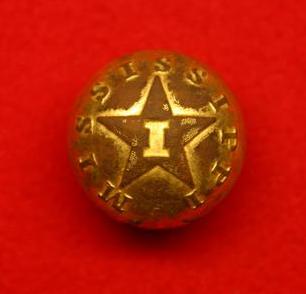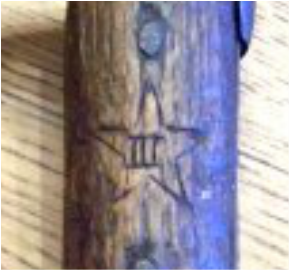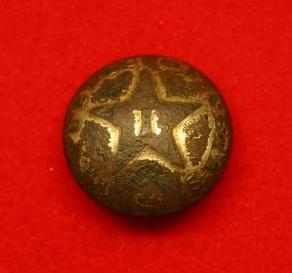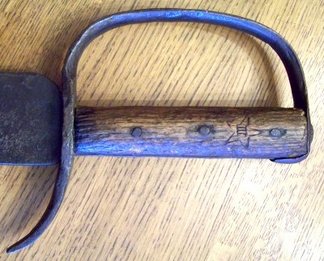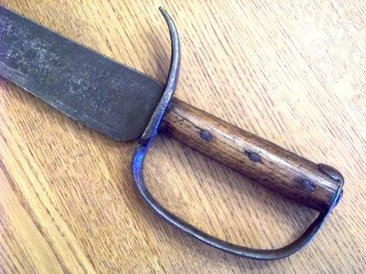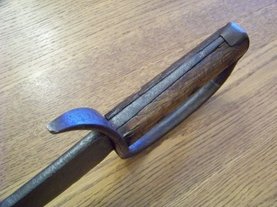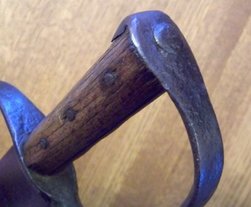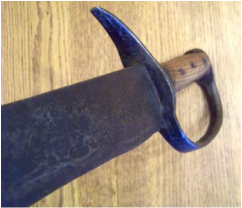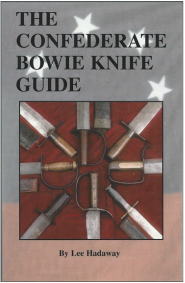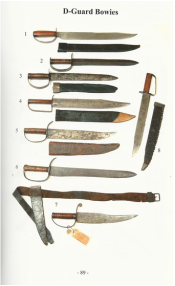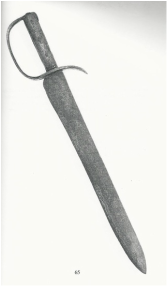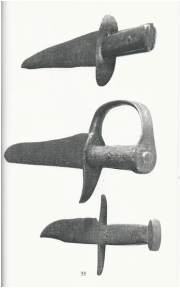Confederate Bowies
Confederates preferred a knife with the now classic D-guard. The bigger the better and were intended as yankee slayers. There are numerous period reports of the presence of these weapons during the many close quarter fighting. Some were practical while some were ridiculously large and no doubt many were discarded during arduous marches. No other weapon produced during the Civil War represents the desperation, innovation and misguided romantic notions than the Confederate D-guard, Hundreds of these prized war trophies were carried home by union soldiers.
D-GUARD ATTRIBUTED TO LEECH & RIGDON
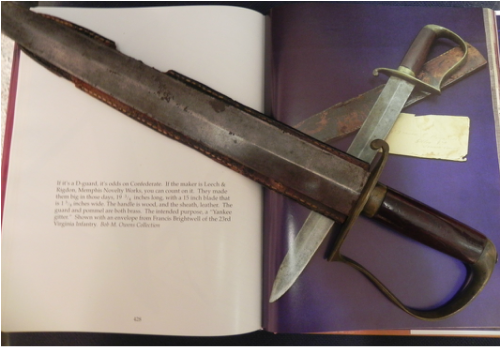
This extremely rare Confederate D-guard Bowie Knife is attributed to Leech & Rigdon. This exact knife is featured on pages 428 & 429 (picture on left and above) of "The Antiques Bowie Knife Book" by Bill Adams and was bought directly from his collection. The caption in the book reads "If it's a D-Guard, it's odds on Confederate. If the maker is Leech & Rigdon, Memphis Novelty Works, you can count on it. They made them big in those days, 19 3/4 inches long, with a 15 inch blade that is 1 5/8 inches wide. The handle is wood and the sheath, leather. The guard and pommel are both brass. The intended purpose, a "Yankee gitter." Shown with an envelope from Francis Brightwell of the 23rd Virginia Infantry. Bob M. Owens Collection".This exact knife was also featured on the cover of North South Trader's Civil War. Volume XXIV No. 2" as part of a Leech and Rigdon product presentation. I SOLD THIS ITEM AT THE POULIN AUCTION MAY9/22
CLASSIC CONFEDERATE D-GUARD
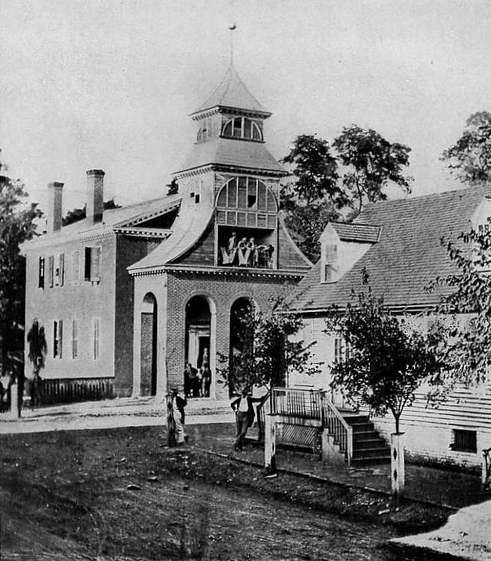 Confederate Prisoners (second floor) at Culpepper Court House
Confederate Prisoners (second floor) at Culpepper Court House
There are hundreds if not thousands of fakes out there when it comes to Confederate knives. This one is 100% unquestionably authentic and untouched in all regards. The piece measures 16 inches in overall length with the blade making up 10-3/4ths of those inches. When they were making side knives they wanted them to be durable and deadly and this one is both. The blade is made of a thick file that was sharpened into a double sided terror. When you look closely at the blade you can see that they made it from a file. This was done to guarantee the durability of the blade in combat. The guard of the knife is made of a simple piece of iron that is about 1 inch wide. In keeping with the simple yet effective design, the handle is made form a single piece of wood. The wood has the gorgeous untouched look. The knife is accompanied by the original leather scabbard. Almost always these scabbards are missing in action. This one is complete and displays superbly. On the back side it has the original belt loop intact. What really makes this one stand out from the rest is the ancient paper label that is affixed to the side of the scabbard. It reads "Presented to Mr. D.G. Nivling by R. J. Sloan Trenton NJ". Then below the ink line it reads "Found During the war at Culpeper Court House by Myself".
"In the early 1860's, one of the most hotly contested areas in the world was North-Central Virginia. Culpeper's strategic location made it a highly prized position for both the North and South, and thus the county witnessed more troop movement than any location in the nation. Within the County, Grant headquartered, Lee camped, Jackson fought and Stuart wintered. In fact, there were more than 160 skirmishes in and around Culpeper during the Civil War. Important Civil War battles were fought in Culpeper County at Cedar Mountain, Kelly's Ford and Brandy Station and within the town of Culpeper Courthouse, now called the Town of Culpeper. On June 9, 1863, more than 17,000 saber-wielding horsemen and 3,000 infantry clashed at Brandy Station in the largest cavalry battle ever seen in the western hemisphere. The Winter Encampment of the Union army during the winter of 1863-64 was the largest encampment of the Civil War, numbering up to 120,000 soldiers."
So not only is this a tremendous Confederate made D-guard Bowie knife in the original scabbard but there is the history of who and where it was from. Purchased from Rafael Eledge who stated that the knife came from a southern Alabama collector who purchased from all over the country.
I had this name professionally researched and received some thirty pages of research. Of particular interest is a note from the researcher stating that she is a direct decedent of D. J. Nivling. She states she was shocked that this knife was picked up one hundred and fifty years ago in a location 20 minutes from her and gave it to a fellow in Pennsylvania who is directly related to her. That marks only the second time in thirty years that she did a research job and ran smack into an ancestor of hers. As she states, her initial reactions was " Nah, Can't be."
(Reference; "The Updated Confederate Bowie Knife Book" by Lee Hadaway; "The Bowie Knife" by Norm Fladerman; " Confederate Bowie Knifes" by Jack Melton, Josh Phillips, John Sexton)
KENANSVILLE D-GUARD
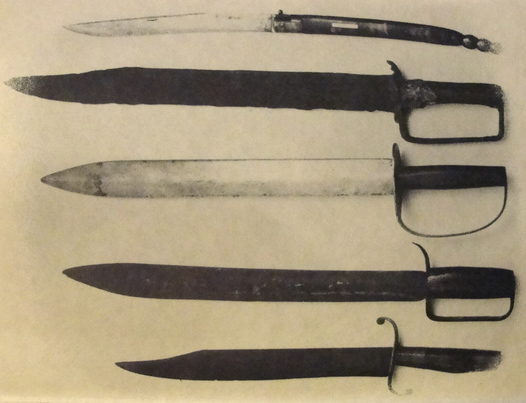 IMAGE OF KNIFE IN THE ADAM'S BOOK
IMAGE OF KNIFE IN THE ADAM'S BOOK
This is a Confederate D-guard bowie knife made by Louis Froelich at the Confederate States Arsenal in Kenansville, North Carolina. Froelich was one of the most prolific blade makers for the South during the American Civil War. Although the name of Confederate States Arsenal would lead one to believe that this facility was owned and operated by the Confederacy, it was actually a private business that was owned solely by Mr. Froelich. It was a fairly sizable operation that produced high quality edged weapons with exacting tolerances. Although most of his products are unmarked, their styling and workmanship stand out as a product made in Kenansville. Such is the case with this knife. The double edged blade shows the superior skill of the craftsman. While it is indeed a forged blade there are no hammer marks that attest to the knife's crude beginnings. The oval cross guard that tapers into the D guard is Froelich's trademark and the chief factor in determining where it was manufactured. The blade and guard are overall very clean with only the slightest trace of pitting and age. The walnut grip is likewise in remarkable condition to be 150+ years old. It shows minimal dings and wear. This specimen is a rarer variant of Kenansville products and has the simple one-piece grip in rectangular form with no ferrules. It has the distinct wider rounded base of the d-guard by the ricasso of the blade, having no quillion at all. This exact knife is featured on the end page of "The Antique Bowie Knife Book" by Bill Adams and was purchased from his collection.Overall length is 21 1/2", the blade length is a 16 1/4", and the blade width is 1 11/16". Comes with a letter from Lee Hadaway.
(Reference: Louie Froelich, Arms Maker to the Confederacy" by John W McAden, Jr. and Chris E. Fonvielle, Jr., page 64; " Confederate Bowie Knifes" by Jack Melton, Josh Phillips, John Sexton, page 79, 80; "Swords of the American Civil War" by Richard H. Bezdek , page 259 ; "Arms and Equipment of the Confederacy" by Time-Life Books, page 78; " The Updated Confederate Bowie Knife Guide" by Lee Hadaway, page 47)
(Reference: Louie Froelich, Arms Maker to the Confederacy" by John W McAden, Jr. and Chris E. Fonvielle, Jr., page 64; " Confederate Bowie Knifes" by Jack Melton, Josh Phillips, John Sexton, page 79, 80; "Swords of the American Civil War" by Richard H. Bezdek , page 259 ; "Arms and Equipment of the Confederacy" by Time-Life Books, page 78; " The Updated Confederate Bowie Knife Guide" by Lee Hadaway, page 47)
MILLEDGEVILLE D-GUARD "RIVER KNIFE"
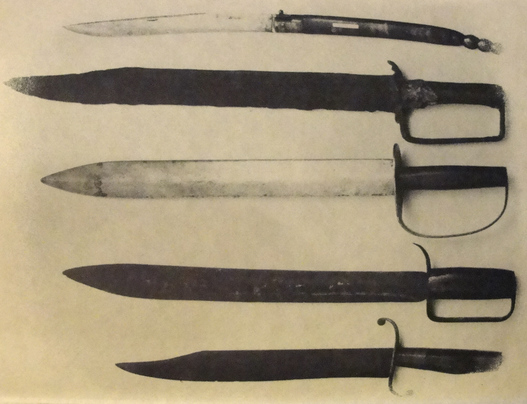 IMAGE OF KNIFE FROM THE ADAM'S BOOK
IMAGE OF KNIFE FROM THE ADAM'S BOOK
In February of 1862, Governor Joe Brown of Georgia issued a plea entitled "To The Mechanics Of Georgia". He asked that all the craftsmen of the state start producing Bowie knives and pikes so that Georgia's soldiers could be armed before they went to fight the Yankees. In response to this, the State of Georgia purchased 4,909 Bowie knives from fourteen different makers. In October, 1864, the inventory of the Georgia State Arsenal in Milledgeville, Georgia showed 3,856 Bowies on hand. This shows that around 1,100 of the Bowies had been issued to the the troops. In late November, 1864, Wilson's Raiders of the 5th Wisconsin Cavalry captured the Georgia Arsenal and shortly thereafter, the Union inventory of the arsenal listed only 1,500 Bowies. Speculation is that the knives which account for the 2300 discrepancy were taken home by the invading soldiers as war trophies. The 1,500 that the official Union inventory accounts for were listed as destroyed. Some were burned but most were loaded into wagons and dumped into the nearby Oconee river along with tons of artillery shells. A salvage attempt was organized in the mid 1980's by John Sexton and Charles Nash. Many divers spent countless hours scouring the Oconee River bottom in hopes of finding this lost treasure and their persistence paid off. A couple of hundred artillery shells were recovered but only a handful of the 1,500 "destroyed" knives were found. This is one of those knives. Even in it's relic condition, there is no doubt that this is one of the Georgia Contract Knives or "Milledgeville Knives" as they are called today. This style is referred to as a "Type 1" by Josh Phillips in his book "Confederate Bowie Knives of the Georgia State Arsenal". The length and width of the blade, the shape of the guard and the ferrule shows that this is one of the Bowies bought by the State of Georgia in 1862, A heavy layer of sediment has built up on the knife after being submerged for 120+ years. The blade, guard and ferrule are intact and remain structurally sound. If the scale was to be removed, the metal surfaces likely would be surprisingly rust and pit free. The walnut grip is intact but shows a few splits. The grip has been covered with a type of wax preservative to prevent further deterioration. There are less than 10 of these "River Knives" that exist today and in the opinion of Lee Hadaway, this is the second best as far as condition goes. One of the other finds is missing the grip and one has the remnants of the leather scabbard stuck to the tip. The best one has the complete scabbard and is shown in the well known picture of the diver. All the others have severely bent blades. This exact knife is featured on the end page of "The Antique Bowie Knife Book" by Bill Adams and was purchase from his collection. Mr. Adams said that he acquired this knife directly from one of the river divers. Rarely does a knife become available that has so much known and documented history attached to it. Even though this knife was never issued, it has it's own unique story to tell. Comes with a letter from Lee Hadaway.
(Reference; "The Updated Confederate Bowie Knife Book" by Lee Hadaway, page 102; "Confederate Bowie Knives of the Georgia State Arsenal" by Josh Phillips, page 29; " Confederate Bowie Knifes" by Jack Melton, Josh Phillips, John Sexton, page 102; " Confederate Arms" by William A. Albaugh lll and Edward N. Simmons, page 139).
In February of 1862, Governor Joe Brown of Georgia issued a plea entitled "To The Mechanics Of Georgia". He asked that all the craftsmen of the state start producing Bowie knives and pikes so that Georgia's soldiers could be armed before they went to fight the Yankees. In response to this, the State of Georgia purchased 4,909 Bowie knives from fourteen different makers. In October, 1864, the inventory of the Georgia State Arsenal in Milledgeville, Georgia showed 3,856 Bowies on hand. This shows that around 1,100 of the Bowies had been issued to the the troops. In late November, 1864, Wilson's Raiders of the 5th Wisconsin Cavalry captured the Georgia Arsenal and shortly thereafter, the Union inventory of the arsenal listed only 1,500 Bowies. Speculation is that the knives which account for the 2300 discrepancy were taken home by the invading soldiers as war trophies. The 1,500 that the official Union inventory accounts for were listed as destroyed. Some were burned but most were loaded into wagons and dumped into the nearby Oconee river along with tons of artillery shells. A salvage attempt was organized in the mid 1980's by John Sexton and Charles Nash. Many divers spent countless hours scouring the Oconee River bottom in hopes of finding this lost treasure and their persistence paid off. A couple of hundred artillery shells were recovered but only a handful of the 1,500 "destroyed" knives were found. This is one of those knives. Even in it's relic condition, there is no doubt that this is one of the Georgia Contract Knives or "Milledgeville Knives" as they are called today. This style is referred to as a "Type 1" by Josh Phillips in his book "Confederate Bowie Knives of the Georgia State Arsenal". The length and width of the blade, the shape of the guard and the ferrule shows that this is one of the Bowies bought by the State of Georgia in 1862, A heavy layer of sediment has built up on the knife after being submerged for 120+ years. The blade, guard and ferrule are intact and remain structurally sound. If the scale was to be removed, the metal surfaces likely would be surprisingly rust and pit free. The walnut grip is intact but shows a few splits. The grip has been covered with a type of wax preservative to prevent further deterioration. There are less than 10 of these "River Knives" that exist today and in the opinion of Lee Hadaway, this is the second best as far as condition goes. One of the other finds is missing the grip and one has the remnants of the leather scabbard stuck to the tip. The best one has the complete scabbard and is shown in the well known picture of the diver. All the others have severely bent blades. This exact knife is featured on the end page of "The Antique Bowie Knife Book" by Bill Adams and was purchase from his collection. Mr. Adams said that he acquired this knife directly from one of the river divers. Rarely does a knife become available that has so much known and documented history attached to it. Even though this knife was never issued, it has it's own unique story to tell. Comes with a letter from Lee Hadaway.
(Reference; "The Updated Confederate Bowie Knife Book" by Lee Hadaway, page 102; "Confederate Bowie Knives of the Georgia State Arsenal" by Josh Phillips, page 29; " Confederate Bowie Knifes" by Jack Melton, Josh Phillips, John Sexton, page 102; " Confederate Arms" by William A. Albaugh lll and Edward N. Simmons, page 139).
OTHER EXISTING MILLEDGEVILLE KNIVES ARSENAL AT MILLEDGEVILLE, DESTROYED NOVEMBER 14, 1864
McELROY BOWIE
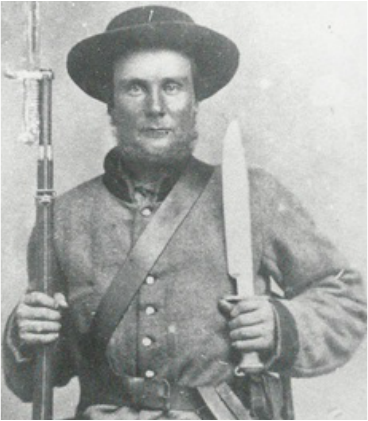
This Confederate Bowie knife was made by W.J. McElroy of Macon, Georgia. Prior to the Civil War, McElroy was Macon's first wholesale manufacturer of tinware. As the winds shifted and war appeared on the horizon, McElroy secured the services of two German cutlers and produced some of the finest edged weapons in either the North or the South. While he was known primarily for his outstanding officer's swords,he also made Bowie knives for the enlisted men. All of his edged weapons were available for private purchase as McElroy had no military contracts with the Confederacy or the State of Georgia. This particular type of McElroy Bowie is often referred to as a "Lasso Knife". In February of 1862, a reporter from the Macon Telegraph toured the McElroy factory. He included in his article a description of the "Lasso Knife". He states "it has a solid brass handle, to which is attached a rope. It is designed for throwing at the enemy". This knife is in relic condition. This one was purchased from the estate of Dr. Stone of Atlanta, Georgia. Fortunately he used Tom Dickey's location numbering system to code this relic. '58' in Dickey's list is for 'Two Hills West of Nodine's Hill, Georgia". This site is on the Kennesaw mountain battlefield.The Guard is intact and undamaged as brass will not rust or corrode. The classic Roman Numerals can still be seen on underside of the guard.The blade is heavily pitted with some significant metal loss but this is expected from a "dug" knife. Even with the poor condition of the blade, it is clear that this knife has a spear point blade, The spear point "Lasso Knives" are much rarer than the more common clip point version. Of interest are the small pieces of leather scabbard stuck to the blade just forward of the guard. This shows that the knife was lost in its scabbard. The belt loop on the scabbard more than likely broke and the knife fell to the ground. These knives were very heavy and the scabbards were of poor quality. In fact, there is only one partial scabbard known to exist for a "Lasso Knife". Mr. Lee Hadaway states that to his knowledge "There are only three dug "lasso Knives" known at this time". One other with a spear point blade is in his personal collection and the other is just the guard. The guard was dug around Atlanta. The fact that this knife and the guard were both recovered in Georgia and lost during Sherman's Atlanta Campaign and his March to the Sea is extremely important. These knives were made in 1861 while brass was still plentiful. After early 1862, they would not have wasted this much brass on a knife grip. The Atlanta Campaign was fought in mid 1864 and for these knives to have been recovered in Kennesaw and in Atlanta shows that they were still being carried into battle by Confederate soldiers. Many skeptics feel that the Bowie knives were discarded early in the war because the soldiers didn't want to carry them on long marches. These knives clearly disprove that theory.One need not wonder whether this knife was shipped home or was at it's owner's side as he faced the invading Yankees. This is one knife that no doubt was there and carried in defense of the Confederacy. Comes with a letter from Lee Hadaway,
(Reference; "Civil War Artifacts" by Howard R. Crouch, page 72; "The Updated Confederate Bowie Knife Book" by Lee Hadaway, pages 104-111; "The Bowie Knife" by Norm Fladerman, pages 200, 211; " Confederate Bowie Knifes" by Jack Melton, Josh Phillips, John Sexton, page 134; "Excavated Artifacts from Battlefields and Campsites of the Civil War 1861-1865" by Stanley S. Phillips, page 163)
"MASSIVE" BLACKSMITH MADE D-GUARD
SAMPLE MISSISSIPPI BUTTON CARVING IN HANDLE SAMPLE TEXAS BUTTON
IMAGES OF THIS KNIFE FROM THE LEE HADAWAY BOOKS
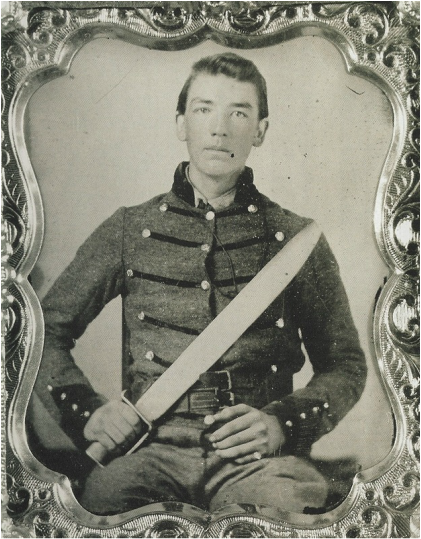
During the Civil War, the Southern soldiers found themselves short of arms in which to repel the invading Yankees. Many Southern blacksmiths used their hammer and anvil to turn out fighting knives for the local soldiers heading off to war. Some of their products were very crude but many showed off the considerable skill of the local craftsman. This knife is anything but crude. Lee Hadaway states that it is one of the finest blacksmith made D-guards he has seen. Besides being a very serviceable and intimidating weapon, it is also elegant in it's style and symmetry. The blade was shaped by hand in a forge but was ground smooth on a grinding wheel. The only evidence of hammer marks remain in the area just forward of the guard. It has full tang that tapers down from the blade toward the pommel. This type of tang is preferred on a large knife as it will support the blade better than a smaller tang that runs inside the grip. It is evidenced by the shape of the guard that much thought was given to it's manufacture. The inside of the D-guard is radiused while the outside is flat. This is a time consuming feature in itself. Also, the way the rear of the guard is rolled the back of the grip shows extra care was taken while making this fine weapon. The rear of the guard is secured to the tang by a rivet. The grips are probably made of hickory and held in place by three iron pins. The overall condition of this knife is above average. The blade and guard are generally smooth and free of rust or pitting. There are numerous areas on the blade that might normally be construed as pitting but they are not. In Mr. Hadaway's opinion, these are occlusions or flaws in the steel. This is common because of the low quality of the steel found in the South. The cutting edge shows evidence of period sharpening but the age of this area matches the rest of the metal perfectly. The guard remains tight to the blade and the peen of the tang is undisturbed. The grip is still relatively tight with only the slightest wobble. That could be because it had been stored in a dry climate in Colorado for many years. The grip has a nice patina and also has some dark coloring around the pins where they have oxidized. The obverse side of the grip has a period carving on it. On it is carved a star with a Roman numeral III. In Mr. Hadaway's opinion, this denotes the 3rd Mississippi Infantry and he believes it was carved by the proud owner of this knife The reverse of the grip has an x stamped in it close to the guard. Mr. Hadaway believes this is some sort of maker's mark as it is stamped rather than carved but we may never know for sure. Both of these marks on the grip show the same amount of wear as the rest of the grip and show a darker patina in their recesses. These marks were obviously put into the grips while the knife was in use during the Civil War. Lee Hadaway purchased this knife from Don Bell in 1995. It was the second Confederate knife he bought and it held a place of honor in his collection until I purchased it in 2009. It is featured on the cover of his first book, "The Confederate Bowie Knife Guide", and on pages 33, 64 & 65. It is also featured prominently in his latest book, " The Updated Confederate Bowie Knife Guide" on pages 29, 58 & 59 and on page 89. The term "massive" is overused when describing knives but I can not think of a better word to describe this knife. It is truly a massive knife but it is also what comes to mind when one thinks of a classic Confederate D-guard Bowie. As Mr. Hadaway states, "This knife is so Southern, it whistles Dixie and smells like magnolias!" Comes with a letter from Lee Hadaway.
